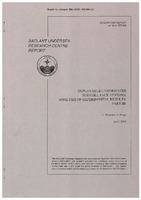| dc.contributor.author | Mozzone, Lorenzo | |
| dc.contributor.author | Bongi, Silvio | |
| dc.date.accessioned | 2018-10-11T14:09:00Z | |
| dc.date.available | 2018-10-11T14:09:00Z | |
| dc.date.issued | 1999/04 | |
| dc.identifier | 12385 | |
| dc.identifier.govdoc | SR-288 | |
| dc.identifier.uri | http://hdl.handle.net/20.500.12489/549 | |
| dc.description.abstract | Deployable Underwater Surveillance Systems (DUSS) are a new active sonar concept based on a distributed network of small multistatic transmitter / receiver nodes. This study analyzes data acquired during the period 29 June to 4 July, 1997, south of the island of Elba, with an experimental DUSS set moored to the sea bed and a towed, calibrated echo repeater target. Maximum detection ranges of 22 km were noise limited, while ranges of operational interest around 10 km were achieved with all target trajectories in reverberation. Sonar equation terms are measured and discussed. The two tested frequencies of 1.9 and 3.5 kHz showed equivalent performance. Multistatic receivers performed as well as monostatic receivers and extended system coverage. Multistatic receivers improved overall Signal to Noise / Reverberation and detection accuracy in an environment with significant signal fluctuations and contact fading. | |
| dc.format | vi, 63 p. : ill. ; 80 fig. | |
| dc.language | English | |
| dc.publisher | NATO. SACLANTCEN | |
| dc.relation.ispartofseries | ADA378131 | |
| dc.subject | DUSS array | |
| dc.subject | Shallow water | |
| dc.subject | Elba Island | |
| dc.subject | DUSS'97 experiment | |
| dc.subject | Multistatic sonar | |
| dc.subject | Underwater surveillance | |
| dc.subject | Sonar arrays | |
| dc.title | Deployable underwater surveillance systems: analysis of experimental results: part III | |
| dc.type | Scientific Report (SR) | |
